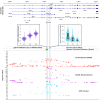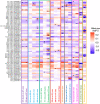Global endometrial DNA methylation analysis reveals insights into mQTL regulation and associated endometriosis disease risk and endometrial function
- PMID: 37587191
- PMCID: PMC10432557
- DOI: 10.1038/s42003-023-05070-z
Global endometrial DNA methylation analysis reveals insights into mQTL regulation and associated endometriosis disease risk and endometrial function
Abstract
Endometriosis is a leading cause of pain and infertility affecting millions of women globally. Herein, we characterize variation in DNA methylation (DNAm) and its association with menstrual cycle phase, endometriosis, and genetic variants through analysis of genotype data and methylation in endometrial samples from 984 deeply-phenotyped participants. We estimate that 15.4% of the variation in endometriosis is captured by DNAm and identify significant differences in DNAm profiles associated with stage III/IV endometriosis, endometriosis sub-phenotypes and menstrual cycle phase, including opening of the window for embryo implantation. Menstrual cycle phase was a major source of DNAm variation suggesting cellular and hormonally-driven changes across the cycle can regulate genes and pathways responsible for endometrial physiology and function. DNAm quantitative trait locus (mQTL) analysis identified 118,185 independent cis-mQTLs including 51 associated with risk of endometriosis, highlighting candidate genes contributing to disease risk. Our work provides functional evidence for epigenetic targets contributing to endometriosis risk and pathogenesis. Data generated serve as a valuable resource for understanding tissue-specific effects of methylation on endometrial biology in health and disease.
© 2023. The Author(s).
Conflict of interest statement
The authors declare no competing interests.
Figures





References
Publication types
MeSH terms
Grants and funding
LinkOut - more resources
Full Text Sources
Medical
Molecular Biology Databases

